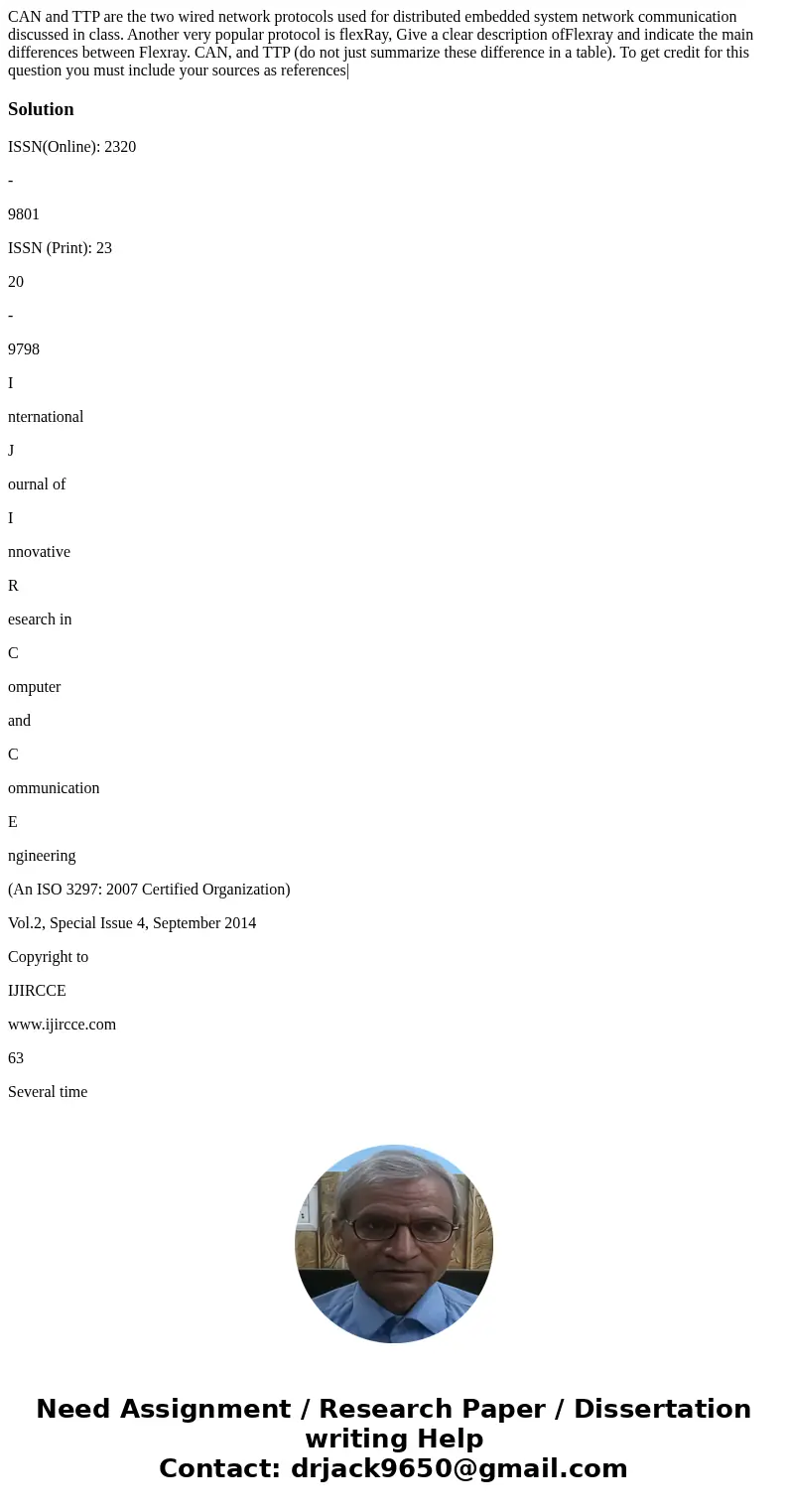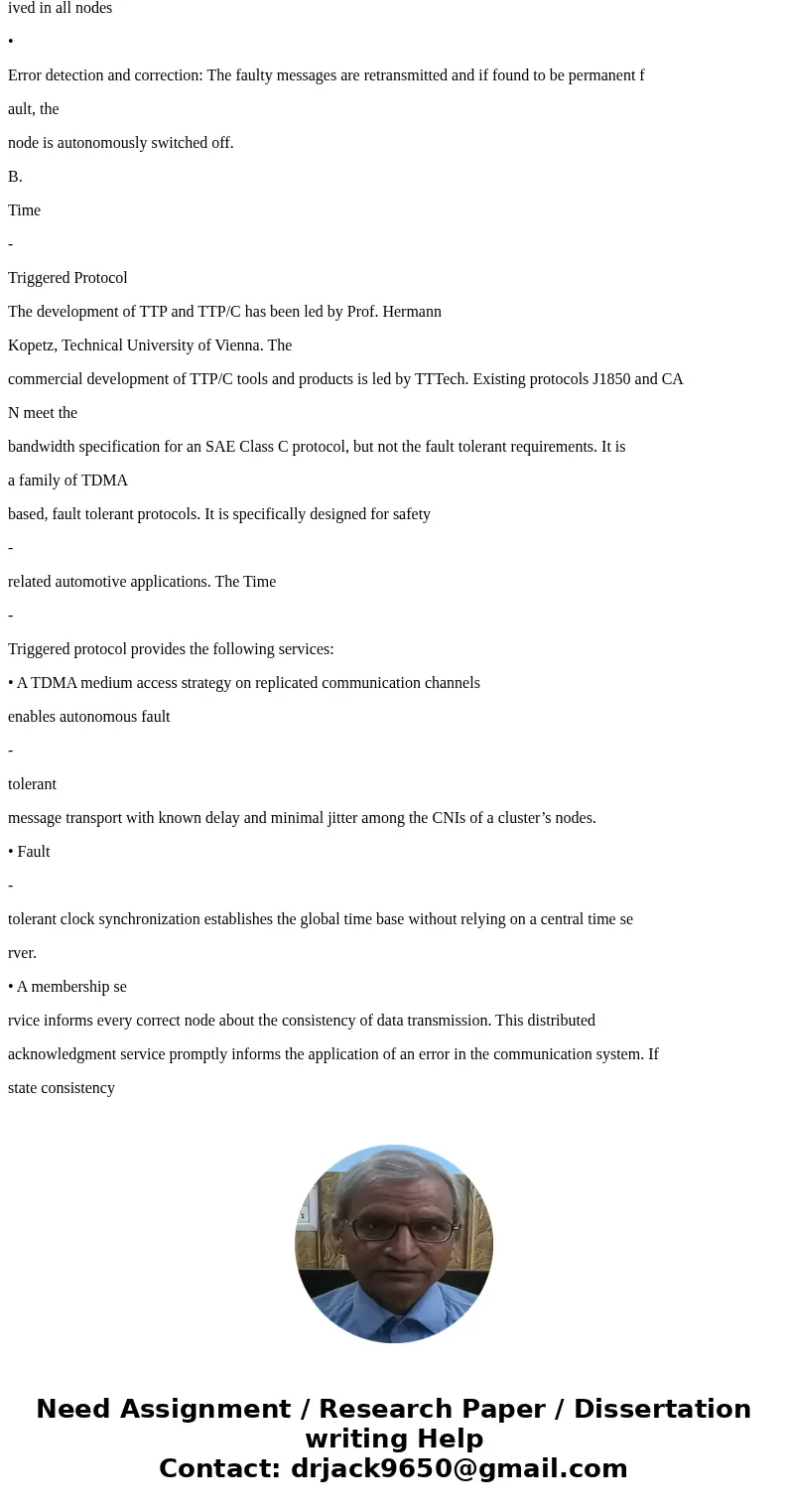CAN and TTP are the two wired network protocols used for dis
Solution
ISSN(Online): 2320
-
9801
ISSN (Print): 23
20
-
9798
I
nternational
J
ournal of
I
nnovative
R
esearch in
C
omputer
and
C
ommunication
E
ngineering
(An ISO 3297: 2007 Certified Organization)
Vol.2, Special Issue 4, September 2014
Copyright to
IJIRCCE
www.ijircce.com
63
Several time
-
triggered technologies su
ch as time
-
triggered CAN (TTCAN
[7], [8]), time
-
triggered protocol (TTP,
[9], [10]), and
FlexRay
[11], [12] have been designed to provide predictable medium access at a higher available
bandwidth. An example
of in
-
vehicle network for a typical car is shown in figure 1 below.
Figure 1.
In
-
vehicle network example.
Time
-
triggered protocol (TTP) has been developed by Technical University of Vienna after two decades of e
xtensive
research. Messages using TTP ar
e statistically schedule based on the progression of time. It has an advantage that it can
precisely control the message transmission and reception time. This characteristic makes it suitable
for safety critical
applications. However, there are three drawb
acks to see: it is inefficient in terms of network utilization and periodic
message response time and the other being lack of flexibility.
Nowadays, either an event
-
triggered or a time
-
triggered mechanism is required for message transmissions in the
vehi
cle network, and in some cases, both of them are required at the same time in complex control system
s. A hybrid
type of protocol has evolved called
FlexRay
communication protocol which allows transmitting both event
-
triggered
and time
-
triggered messages on
the same bus, thus taking the advantages of both approaches.
In this paper, we selected the most commonly used protocol CAN which is an event
-
triggered technology, TTP
which is a time
-
triggered protocol and the newest protocol in the market,
FlexRay
, fo
r comparison. The section II
describes the history and background of the three protocols. The section III will present an overvie
w of how the three
protocols work. A number of different comparisons of the three protocols is made in section IV. Fina
lly, the
real
-
time
demands are discussed in section V followed by conclusions.
II.
HISTORY
AND
BACKGROUND
A.
Controller Area Network
It is a serial bus system, which was developed by Robert Bosch in 1980’s for automotive applications
. The design
was simple, efficient
and robust communication network. The CAN protocol is internationally standardized in ISO
11898
-
1 and comprises the data link layer and components of the physical layer of the 7
-
layer ISO
-
OSI reference
model. CAN, which is now available from more than 50 s
emiconductor manufacturers in hardware. The main
principles of CAN are:
•
Multi
-
master: Any node may send if the bus is idle.
•
Guarantee of latency times: It is possible to calculate the worst case time for a message to be sent
and reached
at the destina
tion node.
•
Configuration flexibility: Nodes can be added to the network without change in hardware or software.
•
Prioritization of messages: Conflicts are avoided by prioritizing the messages.
•
Broadcast communication: Every transmitted message is rece
ived in all nodes
•
Error detection and correction: The faulty messages are retransmitted and if found to be permanent f
ault, the
node is autonomously switched off.
B.
Time
-
Triggered Protocol
The development of TTP and TTP/C has been led by Prof. Hermann
Kopetz, Technical University of Vienna. The
commercial development of TTP/C tools and products is led by TTTech. Existing protocols J1850 and CA
N meet the
bandwidth specification for an SAE Class C protocol, but not the fault tolerant requirements. It is
a family of TDMA
based, fault tolerant protocols. It is specifically designed for safety
-
related automotive applications. The Time
-
Triggered protocol provides the following services:
• A TDMA medium access strategy on replicated communication channels
enables autonomous fault
-
tolerant
message transport with known delay and minimal jitter among the CNIs of a cluster’s nodes.
• Fault
-
tolerant clock synchronization establishes the global time base without relying on a central time se
rver.
• A membership se
rvice informs every correct node about the consistency of data transmission. This distributed
acknowledgment service promptly informs the application of an error in the communication system. If
state consistency
is lost, this service will quickly notify th
e application.
• Clique avoidance detects faults outside the fault hypothesis that are intolerable at the protocol
level.
C. FlexRay
The
FlexRay
consortium emerged after BMW and DaimlerChrysler realized that available solutions did not meet
their future n
eeds for data throughput and determinism. In September 2000, they joined forces with Frees
cale and
Philips and formed the
FlexRay
consortium to establish
FlexRay
as the de facto industry standard. The first vehicle to
use
FlexRay
protocol was BMW X5 in 2006
but the BMW 7
-
series was introduced in 2008 fully utilizing the protocol.
•
Deterministic communication
•
Support for on
-
demand communication (not to interfere with the deterministic communication)
•
Scalable fault
-
tol
erance.
•
Dual channel data rate of 10 Mbps.
•
Support for composability
•
Predictable behavior at absence of node or presence of error conditions.
•
A network wide consistent view of time with a known accuracy of all nodes.
•
Distributed computing through
a global time clock
•
As backbone network, working in conjunction with already established systems (such as CAN, LIN etc.)
.
III.
OVERVIEW
OF
THE
PROTOCOLS
A.
Controller Area Network
A typical vehicle can contain two to five separate CAN networks operating at d
ifferent transmission rates. A low
speed CAN be used for non
-
critical applications like seat and window movement controls operate at less than 125 kbps.
They have an energy saving sleep mode in which nodes stop their oscillators until a CAN message awak
ens
them. A
higher speed CAN interconnect the more real
-
time critical functions such as engine management, anti
-
lock brakes, and
cruise control. Although capable of a maximum baud rate of 1Mbps, the electromagnetic shielding requ
ired makes it
costly.
The C
AN protocol defines the Data Link Layer and parts of the Physical Layer. The protocol specifies a 5V
differential electrical bus as the physical interface. Most of the layers of the ISO/OSI protocol st
ack are implemented
by the software developer [13]. In
the physical layer following properties are discussed:
•
Bit Encoding/Decoding
•
Bit Timing and synchronization
•
Physical Medium
•
Data Rate vs. Bus Length








 Homework Sourse
Homework Sourse